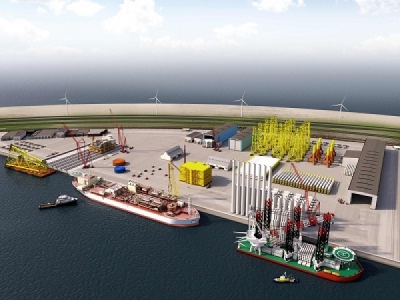
Posted on November 2, 2017
With five major windfarm projects off the Dutch coast in the pipeline, the Port of Rotterdam is stepping up efforts to attract the sector – including the construction of reclaimed island to house a cluster of offshore service providers.
By the end of the year, the five tenants to occupy the 70ha site will be announced and the first section of the reclaiming work will be completed. When finished, the facility will offer around 1,600m of deep water, heavy duty quay walls and plenty of space on reinforced foundations for construction, assembly and storage – as well as repair and maintenance – of offshore equipment.
The Offshore Center Rotterdam will offer space to companies that concentrate on offshore, energy, logistics and heavy lifting activities. Joost Eenhuizen, maritime and offshore business development manager, Port of Rotterdam explains that the facility will also offer the space for companies to develop and test large scale innovations, boosting knowledge sharing and innovative capability.
Equally innovative is the port’s approach to leasing the site. “We didn’t want to negotiate individually with companies because then you end up in arguments over who should have the most space, etcetera,” says Eenhuizen. “Instead we want the companies to think about how best they could use the space together. So we will lease it to the tenants in combination.”
One month after the planning was approved for the Offshore Center a contract was signed for a joint venture between two Rotterdam-based companies, Boskalis and van Oord, to reclaim the land. Construction began in mid-July and the land will be completed this month. The sand needs a settling period and the building of terrain, roads, buildings and the quay walls are planned for the second half of 2018, with the first quay wall operational by mid-2019.
The centre will open as planning begins for five offshore wind projects off the Netherlands coast that will be among the biggest offshore installations in the world (see table). The northerly location of Dutch offshore wind projects so far means that Rotterdam has yet to benefit significantly from that business, but the Offshore Center – along with other developments targeting the wind sector – mean it is unlikely to miss out as the big five windfarms progress.
ATTRACTING BUSINESS
Another sign of the port’s intent is the recent opening of offshore foundation specialist Sif Group’s production centre of monopiles, in Maasvlakte 2, the same area as the new services island. In 2015, as demand increased for wind at sea, Sif was on the lookout for a new production site close to the North Sea, where it could load monopiles directly onboard sea-going vessels.
Jan Bruggenthijs, CEO, Sif Group explains: ‘It was important to have a manufacturing, storage and transhipment terminal close to the North Sea – where the wind parks that we make the foundation piles for are springing up.”
The 42ha site at Maasvlakte 2 now boasts a 50x500m assembly hall and a coating hall, where foundation piles of 80m length and 11m diameter are made. The type of vessels serving the facility mean that Sif quays are the deepest in the whole port. The Port Authority constructed a 400m long deep-sea quay which also boasts the highest retaining walls in the port, at 30m.
The port authority has also instigated the Rotterdam Offshore Wind Coalition to bring together companies operating in the sector with a view to addressing upcoming challenges.
The Port of Rotterdam supports – along with other big players in the area including Van Oord, Boskalis and EY – a maritime and port ‘accelerator’, PortXL, which aims to identify start-up businesses with potential for solving problems across sectors.
While PortXL goes far beyond the wind sector, many of the companies involved do have potential application in offshore wind. Examples over the past two years, since the accelerator began, include augmented reality to improve maintenance, and drone security vessel technology. Other companies relate more directly, such as Fibre Sail, a company with a solution for monitoring the curvature of sails and therefore allowing operators to keep turbines within a range for optimum efficiency.
The Port of Rotterdam is understandably keen to build its offshore wind ecosystem. The Dutch government is aiming to fulfil 16% of the country’s energy demand from renewable sources by 2023. In 2015, it managed just 5.8%. That makes the five big wind projects to come online over the next six years critical to the government’s success. The port authority is making sure it is in prime position to handle a sizeable chunk of that business.
Source: Motorship





